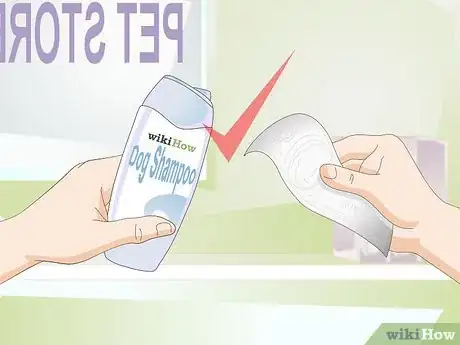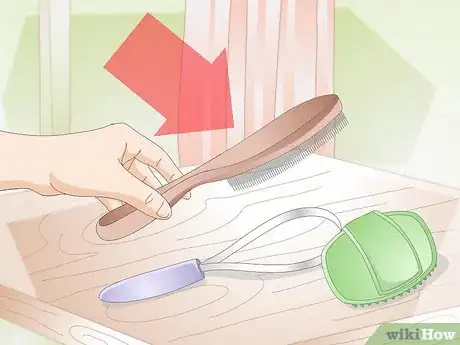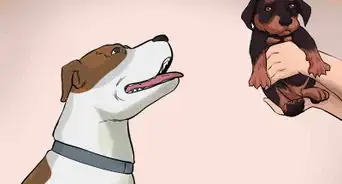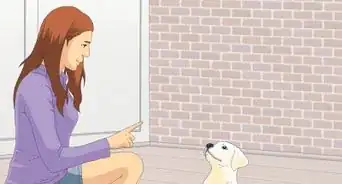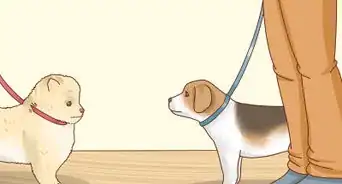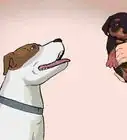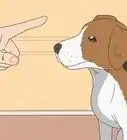This article was co-authored by Pippa Elliott, MRCVS. Dr. Elliott, BVMS, MRCVS is a veterinarian with over 30 years of experience in veterinary surgery and companion animal practice. She graduated from the University of Glasgow in 1987 with a degree in veterinary medicine and surgery. She has worked at the same animal clinic in her hometown for over 20 years.
There are 7 references cited in this article, which can be found at the bottom of the page.
This article has been viewed 30,749 times.
With a new puppy, it can be a challenge to know the best way to bathe them without causing them stress or making them uncomfortable. Choosing the right shampoo and bath products, and taking a few simple steps to keep your puppy happy and comfortable can help make bathtime easier on both you and your pup.
Steps
Using the Right Products
-
1Buy shampoo made specifically for dogs. It's important that you don't use shampoo meant for humans on your dog. Some people think using baby shampoo is okay, but even baby shampoo contains certain chemicals and oils that shouldn't be used on dogs. Use a shampoo marketed and made specifically for puppies.[1]
- Try to avoid buying a puppy shampoo with any added non-natural fragrances and dyes. If the label has anything like “Yellow No. 8” or “Tartrazine,” choose a different shampoo. These artificial ingredients can possibly cause allergic reactions or skin irritation.
- Use shampoos that contain natural essential oils to provide fragrance, rather than chemicals.
-
2Choose a shampoo suited to your puppy's needs.[2] For example, if your puppy has dry or itchy skin, you might consider getting a natural shampoo with oatmeal or essential oils like peppermint and eucalyptus added to soothe his itchiness.[3]
- Medicated shampoos, like those made for controlling fleas and ticks, often cannot be used on puppies younger than 8-10 weeks. Make sure to read the labels on medicated shampoos to make sure they're safe to use on your puppy at his age.
Advertisement -
3Get conditioner made for dogs. Conditioner is important for dogs and puppies because it replenishes the natural oils in their coats that shampoos can wash away. Conditioner is also useful for detangling longer coats, and keeping skin moisturized and healthy.[4]
- Never use conditioners meant for humans on dogs or puppies. Conditioners made for humans have a different pH level than those made for dogs, and can irritate their skin. Buy a conditioner made specifically for dogs. You can find them at your local pet supply store.
-
4Buy a dog brush or comb. Depending on the length of your puppy's coat, you will need a brush to accommodate it. For example, longer coats might do better with a brush or comb that has bristles or teeth that are spaced a bit wider. These types of brushes and combs are good for eliminating the mats or knots that longer coats can acquire.[5]
- Shorter coats, or coats that are prone to shedding, do well with closely spaced bristle brushes. This will help pull out shedding fur and keep your puppy's coat healthy.
-
5Use a shower head that detaches. You can find one of these at your local big box or hardware store. A shower head that detaches and has a hose will be the easiest method for showering your puppy, as it will extend down to where you puppy is in the shower and make it easier to rinse him.
- Most of these types of shower heads allow you to twist a knob to turn off the water momentarily. To save water and keep the water from spraying everywhere while you soap up your dog's coat, turn off the water pressure when you aren't using the water.
- This type of shower head will also let you use a gentler water pressure. You don't want to use a high powered pressure setting. Use the light shower setting on your shower head when showering your puppy.
Giving Your Puppy a Shower
-
1
-
2Let your puppy adjust to the water. Take your time and go slow. Let your puppy adjust to the temperature and to the feeling of the water hitting his body. Make sure you don't have the sprayer set to a high pressure that might startle or hurt your puppy.[8]
- Try talking softly to your puppy as you let him get used to the water. This might help keep him calm, and also reassure him that nothing bad is going to happen. It's important he feels safe and comfortable so he doesn't learn to fear showering or bathing.
-
3Wet down your puppy's entire body. Get his entire coat nice and saturated with warm water. Don't spray the water right into his face. Instead, gently tip his head back and aim the water down the back of his neck. You can use your hands to gently wet down his face to assure he doesn't get water in his eyes.
- Using your hose or sprayer, you can reach underneath your puppy's body to make sure you get his underside wet as well. Again, it's important to go slowly and not startle him.
-
4Use a sponge or washcloth to apply shampoo. You can use just your hands, but using something like a sponge, washcloth, or even a special grooming mit will make it easier to spread the soap, and also help you avoid using too much soap. Lather up the soap gently with your hand or sponge, moving it in circular motions on the dog's coat. Pay special attention to areas that are especially dirty, like legs and feet.[9]
- It helps to start at the head and work your way back to the tail.[10] This will pull dirt and grime down the dog's body as you wash him, and make it easier to wash it out when you're done shampooing.
-
5Take extra care when cleaning your puppy's face, head, and ears. Make sure you don't put soap or water into your puppy's eyes or ears. Ears need to be cleaned with special ear cleaning solution, and your vet should provide you with instructions for this. Use a washcloth to gently wipe down your dog's face to avoid getting soap in his eyes or mouth.[11] [12]
- If you get soap in your dog's eyes unintentionally, rinse gently with clean water. Follow instructions on the label of the shampoo bottle should this occur.
-
6Rinse the shampoo carefully. Again, make sure you tilt your puppy's head back gently, and shield his eyes with your hand so no soapy water runs into them as you rinse. Start from his head, and rinse towards his back end. Run your hand over his coat to get all the suds out as you rinse. Make sure you rinse until the water runs soap-free.[13]
- Make sure your dog's toes get rinsed, too. If you have the bath water filled up, rinse his toes a second time once you've drained the water out.
- Leaving soap in the fur can lead to irritation of your puppy's skin, so it's important that you get all the soap out when rinsing.
-
7Smooth some conditioner through your dog's coat. Depending on the type of conditioner you bought, it might say on the label to let it sit for a minute or two so it can soak in and detangle and soften the coat. Follow the specific instructions on the label, rinsing again carefully afterward.
- If your dog has a longer coat, use a wide-toothed comb to evenly distribute the conditioner through the coat. This will also help detangle your puppy's coat as you work the conditioner in.
-
8Dry your dog gently with an absorbent towel.[14] You can even use a special pet-drying towel sold at many pet supply stores. Microfiber towels seem to offer the most absorbency when drying a wet pup. Start with your puppy's head, as his wet face might be making him uncomfortable.[15]
- Work your way down your puppy's body, being careful not to mat his fur with rough drying motions. Make sure you dry his feet once you've carefully lifted him out of the tub or shower. Slippery wet feet could be dangerous for your pup if he falls or trips.
Keeping Your Puppy Clean Between Showers
-
1Use a waterless shampoo. There are many waterless shampoos on the market for dogs, and you can purchase them at your local pet supply store. Some come as sprays, others as foams, and most involve combing the shampoo through your puppy's coat and then rubbing them dry with a towel or letting them air dry.
- Just like when looking for a regular shampoo, avoid purchasing a waterless shampoo with artificial dyes or fragrances. These might irritate your dog's skin.
-
2Brush your dog. Depending on the length of their coat, you'll need to do this more or less often. The longer the coat, the more prone it will be to knotting and matting, so brushing every few days to every week will be important. Shorter coats can be brushed every few weeks to remove dead or loose hair from their undercoats.[16]
- If your dog does have some knots or mats, use a bit of dog conditioner to detangle it and gently comb it out.
- Make sure to brush in the direction of hair growth, rather than against the grain. Dogs don't like their hair to be brushed in the wrong direction, and it could lead to worse knots rather than helping eliminate them.
-
3Wipe their paws. Use baby wipes, damp towels, or specially made dog wipes to wipe your puppy's paws down after coming in from outside. You can also use these wipes or towels to wipe your puppy's entire body down if he gets a bit dirty, or caught in the rain. This will keep them from tracking dirt inside, and will help slow down the accumulation of dirt on their coats between baths.
Expert Q&A
-
QuestionHow do I give my puppy a shower for the first time?
 Lancy WooLancy Woo is a Certified Pet Groomer and the Owner of VIP Grooming, a pet grooming salon based in San Francisco, California. VIP Grooming has served San Francisco for over 35 years. Lancy received her pet grooming certification from the WWPSA (Western Word Pet Supply Association). VIP Grooming has been voted "Best in the Bay" in 2007, 2010, 2011, 2014, 2017, 2018, and 2019 and won Bay Woof’s "Beast of Bay" in 2014. In 2018, Lancy's work contributed to VIP Grooming's acceptance onto San Francisco's Office of Economic and Workforce Development's Legacy Business Registry.
Lancy WooLancy Woo is a Certified Pet Groomer and the Owner of VIP Grooming, a pet grooming salon based in San Francisco, California. VIP Grooming has served San Francisco for over 35 years. Lancy received her pet grooming certification from the WWPSA (Western Word Pet Supply Association). VIP Grooming has been voted "Best in the Bay" in 2007, 2010, 2011, 2014, 2017, 2018, and 2019 and won Bay Woof’s "Beast of Bay" in 2014. In 2018, Lancy's work contributed to VIP Grooming's acceptance onto San Francisco's Office of Economic and Workforce Development's Legacy Business Registry.
Certified Pet Groomer Your puppy may be nervous about its first shower, but be patient and slowly let them get comfortable. Make sure the water isn't too hot or cold for your pup.
Your puppy may be nervous about its first shower, but be patient and slowly let them get comfortable. Make sure the water isn't too hot or cold for your pup.
Things You'll Need
- Dog shampoo
- Dog conditioner
- Microfiber towel
- Waterless shampoo
- Dog brush or comb
- Dog wipes
References
- ↑ http://www.dogsnaturallymagazine.com/how-to-choose-a-safe-shampoo/
- ↑ Lancy Woo. Certified Pet Groomer. Expert Interview. 26 February 2020.
- ↑ https://www.animalbehaviorcollege.com/blog/grooming/best-dog-shampoos-for-all-coat-and-skin-types/
- ↑ https://www.animalbehaviorcollege.com/blog/grooming/best-dog-shampoos-for-all-coat-and-skin-types/
- ↑ http://www.peteducation.com/article.cfm?c=2+2099&aid=789
- ↑ Lancy Woo. Certified Pet Groomer. Expert Interview. 26 February 2020.
- ↑ http://www.petful.com/grooming/wash-your-puppy-instructions/
- ↑ http://www.petful.com/grooming/wash-your-puppy-instructions/
- ↑ http://www.petful.com/grooming/wash-your-puppy-instructions/
- ↑ Lancy Woo. Certified Pet Groomer. Expert Interview. 26 February 2020.
- ↑ Lancy Woo. Certified Pet Groomer. Expert Interview. 26 February 2020.
- ↑ http://www.petful.com/grooming/wash-your-puppy-instructions/
- ↑ http://www.petful.com/grooming/wash-your-puppy-instructions/
- ↑ Lancy Woo. Certified Pet Groomer. Expert Interview. 26 February 2020.
- ↑ https://dogs.thefuntimesguide.com/2006/05/dogfriendly_microfiber_towels.php
- ↑ http://dogtime.com/dog-health/general/132-brushing
About This Article
To shower a puppy, start by adjusting the water temperature so it's warm but not hot. Also, make sure the shower head is set on the lowest pressure setting. Next, put your puppy in the shower and let it adjust to the water. Then, wet your puppy's whole body and use a sponge or washcloth to apply some dog shampoo, being careful around its ears, eyes, and nose. You can also apply a dog conditioner after you rinse out the shampoo. Finally, rinse your puppy thoroughly and dry it off with a towel. To learn how to keep your dog clean in between showers, scroll down!
